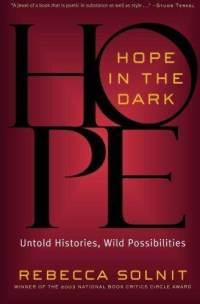
Reviewed by MA SLM student Jake Skinner
The purpose statement of the reading is the proposition of a “new vision of how change happens”. Solnit wanted to achieve this by counting some of the overlooked victories. She also wanted to assess the world we inhabit and wanted to debunk assumptions about activism. Her primal spark for the book though was the 2003 peace movement, which was unsuccessful in halting the invasion of Iraq.

To me, the book is a testament to the good work that has been done by a plethora of actors in antiglobalization movements. In it, Solnit presents events as sites where battles were won and how in many resistance areas the right people are “winning”. There is an impermeable mantra to carry on. I found that her optimism about social change was infectious and encourages the reader to not dwell on the defeats but to carry on fighting their own battles to achieve their global justice.
Solnit uses several metaphors effectively but I am choosing to mention darkness, hope, antiglobilization movement and paradise. By darkness Solnit is referring to the negative effects of globilization and, more often than not, contemporary capitalism. Her hope is more than just an individual feeling of optimism but the multifaceted nature of activism demanding social change. Antiglobilization is an umbrella ideology that encompasses most social movements demanding justice. Lastly, she discusses the illusion of paradise and how social change is an ongoing engagement in improving social structure and relations.
My favourite quote is “All those years that I went to the Nevada Test Site to oppose nuclear testing, the experience was also about camping in the desert, about the beauty of the light and the grandeur of the space, about friendship and discovery. The place gave me far more than I could ever give it. Resistance is usually portrayed as a duty, but it can be a pleasure, an education, a revelation” (p. 68). I selected this quote because it contradicts the suppression of pleasure most feel whenever duty is mentioned, however it is rare that activities are that polarized. It also stimulates me to broaden my perception and practice of activism.
There were not any direct links to my research, which is social inclusion through park visitation. However, my research is linked to relations of power and the effects of globalization. It has also helped me ground my research back into practices that I feel enact positive social change.
Questions for classmates: A. How does the class feel about the language the text is written in? B. Why do you think we were asked to read this book as a precursor to this course? C. What was your main opinion of it (don’t be shy!)?